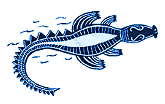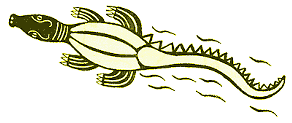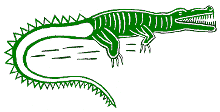Some Aboriginal stories explain why the crocodile is like he is...
Many stories give the croc human characteristics.
He is said to be sneaky, dangerous and not to be trusted.
Why the croc hunts
|
The first crocodile was made by an old man because he could no longer hunt himself. He used a lizard for a model and kept it on a rope. He taught it to fish and catch turtles, dugongs and then men and women. Then the crocodile got loose and decided to hunt for himself. However he never attacked his maker.
(Source: Roth 1984, The first crocodile of Embley and Archer Rivers)
|
 |
How the croc got his teeth
The people of Napranum tell the story of the blue tongue lizard and the crocodile. The croc tricks the blue tongue lizard into lending him his set of powerful teeth for fishing and hunting and never gave them back.
(Source: Roth 1984, The crocodile and the blue tongue lizard)
Why crocs eat people
|
(This story comes from the Djabugai and Yirriganydji clan groups in the Cairns and Kuranda areas. The Yarrabah range seen from Cairns is Ganyarra the crocodile).
"In the Creation, Damarri, a heroic being, strode across the waters of Trinity Inlet before arriving at Bulmbaa Giyi:ngarra (place of the lawyer vine). Here Damarri trod on a lawyer vine thorn and began to bleed. He decided to retrace his steps. Ganyarra the crocodile smelt Damarri's blood and followed him across the inlet to the mouth of the Barron River. Here Ganyarra tried to bite Damarri's leg off, but he couldn't because he didn't have any teeth. |
 |
Damarri, a daredevil happy-go-lucky sort of fellow, laughed at Ganyarra. He went and made him some teeth from the white mangrove. When Ganyarra received his gift from Damarri he turned around and bit off Damarri's left leg. Then Damarri told Ganyarra to go and hunt people. This explains why, when given the chance, crocodiles eat people."
(Source: 'Walk on the Wild Side', Botanical Gardens, Cairns City Council)
Why there is croc dance and song
Some Aboriginal and Torres Strait Islander people have the crocodile as their totem. They believe that the croc is a hero and they cannot be harmed by him. This is a story from the Torres Strait.
One cloudy night when there was no moonlight, some kaigas men (men with the shovel-nosed ray totem) went dugong hunting. They killed a crocodile by mistake. They took it to the crocodile people who, seeing it burst into tears. The croc was their totem (kadal). They mourned it for many days afterwards.
So the shovel-nosed ray men went to a creek on Badu Island. They harpooned another croc and looked at it very carefully. Then they returned to their island and made a croc mask carved from turtle shell. The mask could be worn over a man's head.
|
When the mask was finished, the shovel-nosed ray men took it to the crocodile men. They gave it to them and said, "We have made this crocodile for you".
The crocodile people dried their tears and danced around their mask. The mask is now used in crocodile song, dance and
ceremonies giving out food.
(Source: Myths and legends of Torres Strait, M Lawrie, UQP)
|
 |
How the croc became 'saltie'
|
T he croc is totem to the people of Edward River (Pormpuraaw) on western Cape York. This story tells how the estuarine croc ended up in the saltwater.
At one time, Pikuwa, the estuarine croc and Kena, the fresh- water croc, were men. Kena and Pikuwa had a fight over a woman. They fought and fought. Kena speared Pikuwa in the ribs. Pikuwa hit Kena with a firestick in the neck.
They fought to the end. Kena lay down and stayed there. The place became known as the place of the sick crocodile. Pikuwa went towards the sea to get well in the saltwater. Everyone sang to him to get well. They sang to his legs to get well. They sang to his arms to get well. |
- crocs role in Indigenous culture (including vision of croc feeding and close ups) (47 secs, 344 K) view
|
|
It was no use. They carried him to the saltwater. Pikuwa did not want to go back in case Kena killed him. He went down in the salt water. All was over.
(Source: Myths of the Munkan, McConnel, 1957, MUP)
|